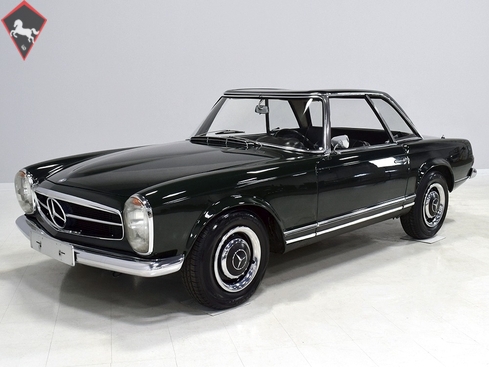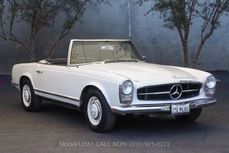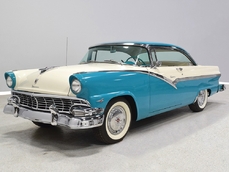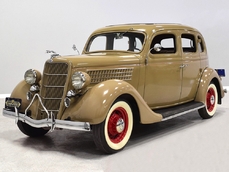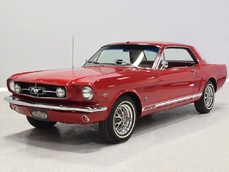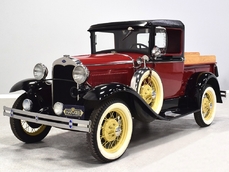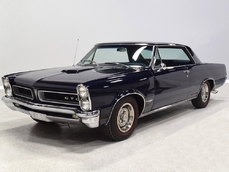Mercedes-Benz 250SL w113 2.5 liter inline-6 1967
Allgemeine Beschreibung :
Relevant details: Euro-spec 4-speed 250SL, matching-numbers engine documented by Mercedes-Benz data card, lifetime California car, the notches are intact, the spot welds are mostly visible despite a thick older repaint, and this is a rare and unusual California Coupe, which has a back seat but no convertible top.
OK, if you’re still here, then you’re obviously still interested in this lovely SL. You may be asking yourself, “What’s a California Coupe?” In late 1966, Mercedes-Benz decided to bolster the brand’s presence on the west coast of the United States, which was home to the booming car culture. The result was the California Coupe, a 250SL with a removable hardtop and a back seat, but no convertible top (the logic being, of course, that in California you wouldn’t need it). From all external appearances it is 100% SL, but when the top is off, you have a little extra room and thanks to a bit less weight, it offers a bit more performance, too.
We don’t know where this SL was originally delivered, but given the metric speedometer and the large B on the tail, we suspect it was perhaps Belgium. Shortly thereafter, it arrived in California, its namesake, where it spent the next 45 years. It wears its original color combination of Dark Olive paint with a black hardtop and matching black hubcaps, which makes it look understated and substantial, a look we like a great deal. It appears that it is a combination of original paint on the hood and deck, while the sides of the car have been repainted. Why, we can’t say, but the color match is quite good and aside from a thin spot on the hood where it has been buffed through, it looks great. Not perfect, but if you want a casual SL that’s easy to drive and offers no worries in the real world, it’s ideal. It doesn’t appear to have ever been hit or damaged, and panel fit is excellent, which is typical of the Pagoda. The all-important notches on the front fenders are clearly visible and while the repaint seems to have been thick enough to obscure some of the spot welds on the inner fenders, they’re still evident. Doors close with authority and both the hood and trunk lid fit flush with no issues. You will also note that the usual trouble spots in the rear valence under the bumpers are clean. The only possible issue might be a small rust spot near the jack spot on the right side rocker panel, but you really have to examine it closely to even see it.
The Euro-spec cars offer the handsome headlights that were designed for the car, not the homely US-spec lights that were a compromise with the Feds. There’s also a square fog light on the tail, another European feature, and without the US-spec overriders on the bumpers the design is extremely clean. There’s just no angle from which this car doesn’t look great.
We strongly believe the black leather interior is original, which speaks to the car’s excellent preservation. There’s some moderate wear on the driver’s seat but no splits, tears, or other damage, and it appears that even the carpets are original. The door panels are excellent and the wood on top of the dash is in very good condition, needing little more than some linseed oil to buff up to a soft shine. No cracks in the steering wheel or the dash pad, and yes, that’s a 4-speed manual shifter on the transmission tunnel. All the gauges are fully operational and you’ll note that the speedometer is measuring in KPH, not MPH. The Blaupunkt AM/FM/shortwave radio is an awesome addition and powers up, although we haven’t tested all its functions. The sliders for the heat/defrost are excellent and even the map light illuminates when you open the glove box. Sadly, the clock is not working, but it seems to be the only thing in the entire car that isn’t working as it should. A glance behind the front seats and you’ll see how the California coupe is different—a full-width bench seat that could probably accommodate adults for short trips but is probably best reserved for children. Better yet, it folds down to create a rather large parcel shelf which, combined with the trunk, offers quite a bit of space. And speaking of the trunk, it’s neatly finished with a proper mat, along with a factory jack assembly and tool roll. There is no spare tire, but it shouldn’t be difficult to find one if needed.
The removable hardtop is in excellent condition with a clean headliner, good chrome, and good weather seals. A folding hardtop stand is included with the car for alfresco driving.
The car is powered by its original, numbers-matching 2.5 liter inline-6, which makes for entertaining performance in the relatively lightweight SL. As far as we can tell, it has never been out of the car and runs superbly today. Turn the key and listen for the fuel pumps to pressurize the system, then kick the starter and let it fire up and idle on its own. After a second or two, it settles into an even 700 RPM idle and is ready to run. No noises, no smoke, and good oil pressure suggest the robust Mercedes-Benz engine is healthy and it pulls with genuine enthusiasm at almost any speed. It’s tidy under the hood, with mostly original finishes used throughout, correct fittings, and factory-style hardware. Aside from a few hose clamps and a replacement firewall insulator, it looks quite authentic. Recent work includes a new master cylinder, correct Bosch coil and distributor cap, as well as new plugs and wires. It’s 100% ready to run.
The desirable 4-speed manual transmission transforms the SL from pleasant little convertible to aggressive-feeling roadster. Clutch action is light and while the shifter is a bit vague, you won’t miss a gear and it feels familiar right from the start. Somewhat tall 3.92 gears in the independent rear end make it feel punchy around town and the six doesn’t mind spinning along at modern highway speeds. There’s a recent exhaust system that gives it that characteristic six-cylinder baritone wail and with both power steering and power brakes, it’s easy for anyone to handle. In addition to the master cylinder, the brake hoses, calipers, and pads are new, and there are fresh shocks at all four corners. The floors, rockers, and other critical areas show their California heritage with exactly zero issues—that’s factory undercoating on the floors, not rust or scale. This is a very solid SL. Factory 14-inch steel wheels with color-matched hubcaps carry new 195/75/14 radials that are so fresh you can still see the protective blue coating on the whitewalls inside.
We’ve sold a lot of SLs, and we like this one most of all. It isn’t the nicest, the most perfect, or the most valuable, but it drives quite well and the 4-speed completely transforms the Pagoda’s personality. If you can live without the folding soft top (which isn’t difficult), it represents a lot of Mercedes-Benz quality and an awesome pedigree for the money. Call today!
http://www.harwoodmotors.com/vehicles/inventory_details.php?id=882
1967 Mercedes-Benz 250SL w113 2.5 liter inline-6 is listed verkauft on ClassicDigest in Macedonia by for $69900.
Fakten der Auto
Karosserietyp : Auto Marke : Mercedes-Benz Modell : 250SL w113 Ausführung : 2.5 liter inline-6 Hubraum : 2.5 Modelljahr : 1967 Lage : Ohio
Verkauft
Angaben Zum Verkäufer
Verkauft
People who viewed this Mercedes-Benz 250SL w113 also viewed similar Mercedes-Benz listed at ClassicDigest
Other cars listed for sale by this dealer
über Mercedes-Benz
In den Annalen der Automobilgeschichte entfaltet sich die Reise von Mercedes-Benz wie eine Erzählung voller Ingeniosität seiner Gründer. Im Jahr 1886 schuf Karl Benz den Benz Patent Motorwagen, eine Kreation, die als das weltweit erste Automobil in die Geschichte eingehen sollte. Unwissentlich markierte dieser Moment den Ursprung dessen, was sich zu einem weltweit renommierten Premium-Autohersteller entwickeln würde. Die finanzielle Basis dieses bahnbrechenden Unternehmens wurde interessanterweise von Karls Ehefrau, Bertha Benz, bereitgestellt, was eine bemerkenswerte Partnerschaft demonstrierte, die den Ton für das Erbe von Mercedes-Benz setzen sollte.Nicht weit entfernt entstand eine parallele Erzählung, als die Daimler-Motoren-Gesellschaft, gegründet von Gottlieb Daimler und Wilhelm Maybach, die Bühne betrat. Im Jahr 1901 enthüllten sie ihr Auto unter dem mittlerweile berühmten Namen "Mercedes", was auf Spanisch "Geschenk Gottes" bedeutet. Dieser Name wurde auf das Auto auf Wunsch von Emil Jellineks Tochter verliehen, dem Vertriebspartner der Daimler-Motoren-Gesellschaft. Die Räder der Innovation wurden in Bewegung gesetzt.
Springen wir vorwärts ins Jahr 1926, ein entscheidendes Jahr, das die Fusion von Daimler mit Benz & Cie. sah, was zur Geburt von Daimler-Benz führte. Die Fusion führte zur Übernahme von "Mercedes-Benz" als das renommierte Markenzeichen für ihre Automobile und verschmolz die Legenden zweier visionärer Unternehmen zu einer.
Entgegen konservativen Wahrnehmungen entfaltet sich die Geschichte von Daimler-Benz als Chronik von Branchenneuheiten. Von der Einführung des Wabenkühlers über den Schwimmervergaser bis zur bahnbrechenden Einführung von Vierradbremsen im Jahr 1924 trieb Daimler-Benz kontinuierlich die Grenzen der automobilen Innovation voran. Der Dieselantrieb des Mercedes-Benz 260 D im Jahr 1936 markierte den Beginn von Dieselmotoren in Personenkraftwagen. Der ikonische Mercedes-Benz 300SL Gullwing schrieb Geschichte als das erste Auto mit direkter Kraftstoffeinspritzung, wenn auch der winzige 2-Takt-Motor des Gutbrod Vorrang beanspruchen kann.
Sicherheitsinnovationen wurden zum Markenzeichen, mit Béla Barényis patentiertem Sicherheitszellen-Design in den "Ponton"-Modellen im Jahr 1951, das Front- und Heck-Knautschzonen umfasste. Der W116 450SEL 6.9 führte die Einführung des Antiblockiersystems (ABS) ein, eine weitere wegweisende Sicherheitsfunktion. Vom ersten serienmäßigen Airbag bis hin zu vielen weiteren Innovationen wurde das Erbe der "Ersten" weiter in das Gewebe von Daimler-Benz eingeschrieben.
Auf seiner über hundertjährigen Reise hat Mercedes-Benz nicht nur Autos produziert, sondern automobile Ikonen geschaffen. Der SSKL, 710 SSK Trossi Roadster, 770K Grosser, 540K Spezial Roadster, 300SL Gullwing, W100 600 Pullman, W111 280SE 3.5 Flachkühler, W113 230SL Pagode, W109 300 SEL 6.3 und W201 2.3-16 Cosworth sind Zeugnisse des Engagements der Marke für Ingenieurkunst.
Die donnernden Silberpfeile, oder "Silberpfeile", darunter der W 25, W 125, W154, W165 und W196, schufen ein Erbe der Dominanz auf der Rennstrecke. Diese Maschinen waren nicht nur Autos; sie waren Ausdruck von Präzision, Geschwindigkeit und einem unbezwingbaren Geist, der die Konkurrenz im Staub zurückließ.
Während Mercedes-Benz in die Zukunft schreitet, tut es dies nicht nur als Automobilhersteller, sondern als Hüter eines Erbes, als Fackelträger der Innovation und als Leuchtturm automobiler Exzellenz. Der Weg in die Zukunft wird zweifellos die Fortsetzung der Verschmelzung von modernster Technologie, zeitlosem Design und dem unerschütterlichen Engagement für die Festlegung neuer Standards in der Welt der Automobile erleben.
